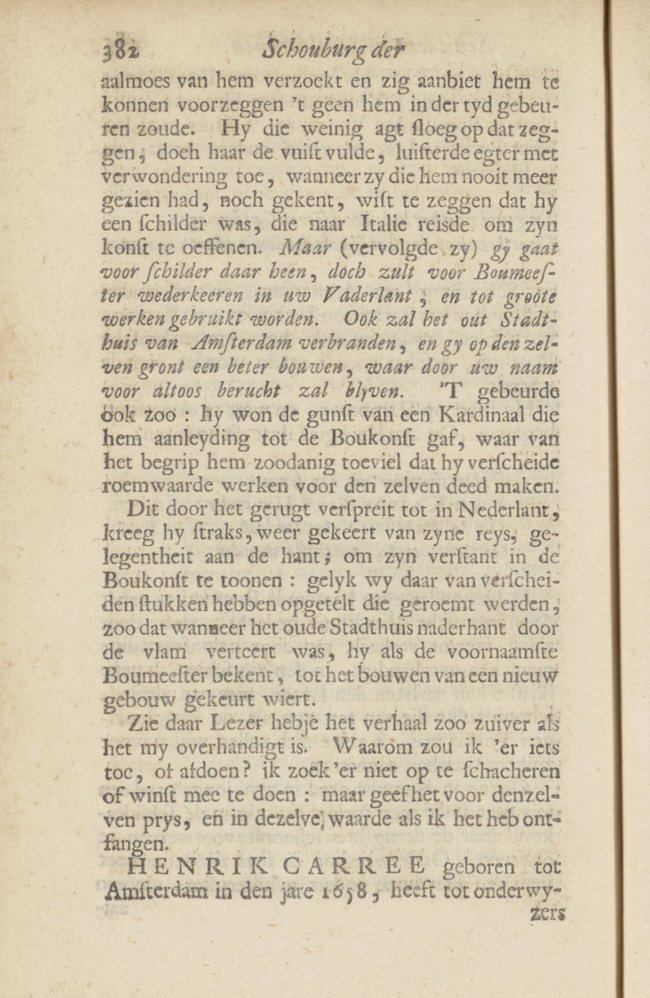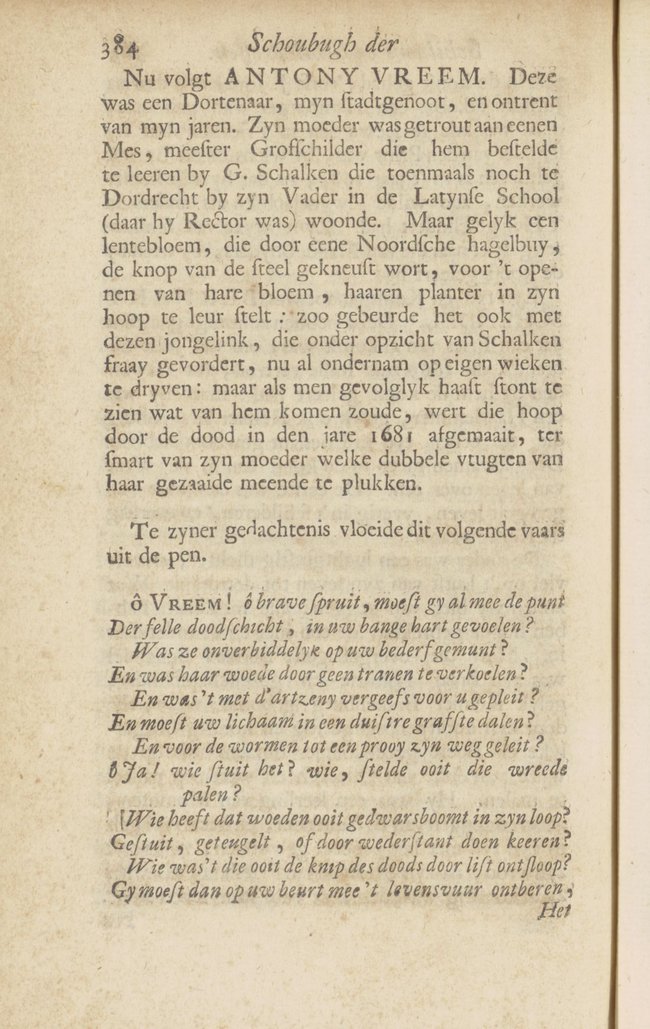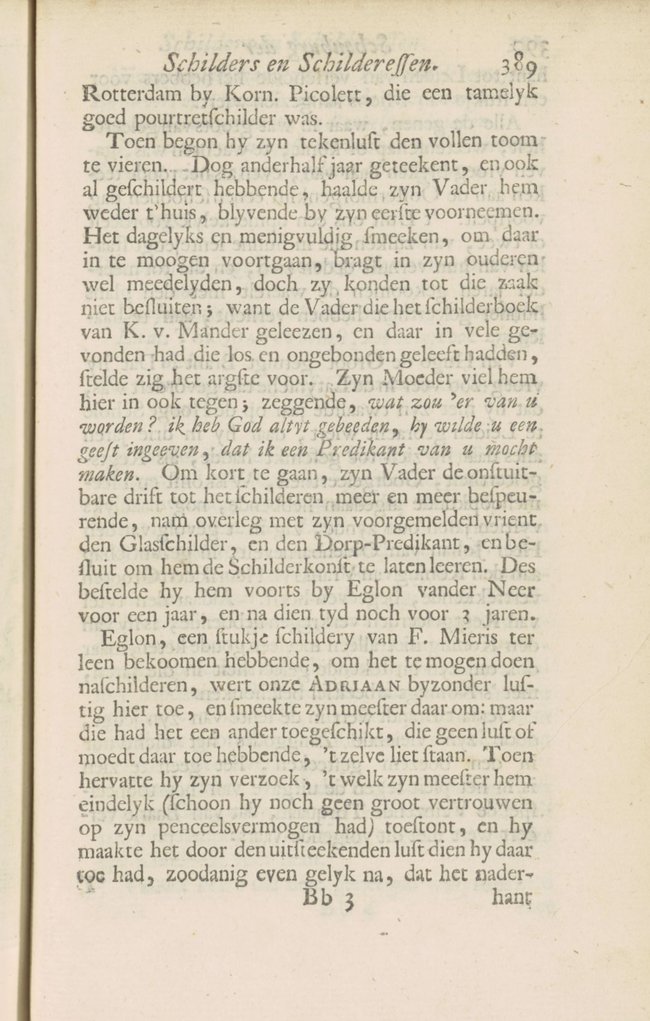Volume 3, page 380-389
Page 380
And sing hallowed verses in his honour.
So that you will light him according to worth an inextinguishable fire.
It appears that Ruelles also understood poetry, as may be deduced from the lament on his passing in April of 1658, in which it is said at the end that he had found a double art with his intellect.
And thou, my Goddess of Song, who loved such a poet,
Hurry now to Daphne, and fetch from her a wreath,
To decorate his head, worthy of fame, with double radiance.
Join him then at his grave, so that neither time nor years
May have his name or fame descend with him into his grave.
Now we need to speak about the famous painter and architect JACOB van CAMPEN, Lord of Randenbroek. He was born in Haarlem, but the year in which his life began is not known to me. I have discovered the time of his death, the 4th of March of the year 1658, in a hack poem named ‘Haarlem’s trumpet of death sounded on the tomb of Mister Jacob van Campen etc.’
His brush work consisted of figures and histories, mostly life-sized, and his way of painting resembled that of Jan van Bronchorst and Jan van Bijlert. But he was no weaker in the art of drawing than in powerful painting, so that I can apply the praise that I have attributed to these two great masters to him alone. And what his marvellous intellect has worked out in architecture appears from a multitude of show buildings in Holland and elsewhere

Page 381
founded by him, such as the house of Prince Johan Maurits in The Hague [1], the house of Mister van Zuylichem [= Constantijn Huygens] and pleasure house in Voorburg [2], the house of Mister Dedel in Lisse, and many others, as in Haarlem
The facade of the house of Mister Guldewagen [= Cornelis Dircksz. Guldewagen]
in which, above the plinth, hunting hounds chase a stag,
the theatre of Amsterdam and various grave tombs of Batavian sea heroes such as Maerten Harpertsz. Tromp [3], Jan van Galen [4], and finally the Amsterdam city hall, believed to be the eighth wonder of the world [5].
He died in Randenbroeck and was buried in Amersfoort. On his church grave this may be read:
The arch architect of the family
Van Kampen rests here below:
Who founded the city hall
Of Amsterdam, the eighth wonder.
Amongst his most famous buildings I thought of the Amsterdam city hall, which brings a certain strange story, passed on by trustworthy people, to mind. I do not want to fail to pass it on to my readers, even though they may share the nature of the doubting Thomas and will not accept is as unadulterated truth.
In his youngest days our Van Campen took a journey to Italy with the intention of practicing the art of painting after the most distinguished and beautiful objects. Under way on his journey he meets a heathen, or a fortune teller,


1
and Pieter Post Jacob van Campen
the Mauritshuis, completed in 1644
The Hague, Municipality of the Hague

2
Pieter Post after design of Jacob van Campen
Hofwijck, summer home of Constantijn Huygens (1597-1687), completed in 1642
Voorburg (South Holland), Municipality of Voorburg, inv./cat.nr. Westeinde 2A

3
and Willem de Keyser (I) Rombout Verhulst after Jacob van Campen and after Willem van de Velde (I)
Funerary monument for Maarten Harpertsz. Tromp (c. 1598-1653), 1654-1658
Delft, Oude Kerk (Delft)

4
and Willem de Keyser (I) Rombout Verhulst after design of Jacob van Campen
Funerary monument for Jan van Galen (1604-1653), completed in 1657
Amsterdam, Nieuwe Kerk (Amsterdam)

5
after design of Jacob van Campen
City hall (now: Royal Palace) of Amsterdam, officially opened on 29 July 1655
Amsterdam, Raadhuis Amsterdam
Page 382
who asks alms from him and proffers herself to foretell what would happen to him in the future. He, who paid little attention to what she said but filled her fist, listened with amazement when she, who had never seen nor known him, was able to say that he was a painter who was travelling to Italy to pursue art. But (she continued) you go there as painter, but you will return to your fatherland as architect and be employed for great works. Furthermore, the old city hall of Amsterdam will burn down, and you will build a better one on the same ground, by which your name shall always remain famous. And it came to pass. He won the favour of a cardinal who introduced him to architecture, for which understanding he had such aptitude that he made several famous works for him.
This rumour having reached the Netherlands, he at once gained opportunity, when returned from his journey, to show his understanding of architecture, as we have mentioned various pieces that are famous, so that when the old city hall was later consumed by flames, he, as the most distinguished architect known, was chosen for the building of a new edifice.
See reader, there you have the story as purely as it was passed on to me. Why should I add or take away anything? I am not out to purvey it to my own profit, but give it for the same price and the same value at which I have received it.
HENDRIK CARRÉ, born in Amsterdam in the year 1658, had as first teacher of art Jacob Jordaens. Then followed

Page 383
Juriaen Jacobsz, came from Hamburg but was a resident of Leeuwarden, where he was painter of the prince, in whose service he also died in the year 1685, after he had painted handsome artworks, both wild boar hunts and others. His way of painting resembles that of Frans Snijders, with whom he had studied art.
His contemporary and fellow artist was BERNARDUS van SCHIJNDEL.
Some have believed that he was Friesian because Jelle Sibrandz, who left for Italy in 1669, had studied art with him. But he was from Haarlem, like Richard Brakenburgh, who also lived in Friesland for some time. These two resembled each other more in art than in way of life. The first was a man of regular life, diligent in painting and in church attendance.
The other was a light-hearted poet and turned to drink at the end of his life. What can we say about this? All men have their failings, the one here, the other there. But leaving this aside Bernardus van Schijndel was a commendable history and society painter, born in 1649 like Richard Brakenburgh. The latter was able to paint with his brush on panel amusing and artful bourgeois and farmer companies in interiors in the manner of Adriaen van Ostade. He was a student of Hendrick Mommers, others say of Bernardus van Schijndel, and made a lot of money with his brush, so that after his death his wife [= Aaltje Hendriks Fenema] could buy room and board for the rest of her life in Friesland, from whence she hailed.

Page 384
Now follows ANTHONY VREEM. He was from Dordrecht, my fellow townsman, and about my age. His mother was married to one Mes [= Samuel Anthonis Vreem], a coarse painter who placed him to learn with Godefridus Schalcken, who then still lived in Dordrecht with his father [= Cornelis Schalcken] in the Latin School (where he was the principal). But just as the bud of the stem of a spring flower is bruised by a northern hailstorm before her flower has opened, disappointing her planter in his expectations, so it happened with this youth, who had been handsomely formed under the supervision of Schalcken and already undertook to stretch his own wings. But when as a consequence, people were about to see what he would mature into, that promise was mowed down by death in the year 1681, to the sorrow of his mother [= Pieternella Reijniers van Wessum], who had hoped to pick double fruit from her sowing.
The following poem flowed from the pen in his memory.
Oh Vreem! Oh commendable sprout, did you have to feel
The point of death’s bolt in your fearful heart?
Did she aim inexorably for your destruction?
And was her wrath not to be cooled by tears?
And did medicine plead for you in vain?
And did you body have to descend into a dark grave?
And put away as prey to worms?
Oh yes! Who stops it? Whoever set those cruel limits?
Who has ever frustrated that rage in its progress?
Arrested, reigned in or turned by resistance?
Who has ever evaded the cut of death by a ruse?
You had in your turn to do without the fire of life.

Page 385
The certain fact that no mortal avoids:
And resign yourself in heaven’s pleasure.
You proceed, we follow with dragging mourning clothes
Where you are carried laureate* into the tomb.
Goddess of art, lament his fate and weep,
And help cypress and laurel entwine his grave stone.
While he sinks into the grave, so that it resounds on the stone,
Where I mix my tears with the pure ashes of his corpse.
I will with time (in spite of death) attach his worthy name
With golden cord to the best of painters,
And surround his memory with fame.
Then the grave will obscure his corpse, but not his name.
DIRCK DALENS II was born in Amsterdam in the year 1659. Spurred on from a young age by seeing art and its handling as well as awakened to it by a great inherited passion, he turned early on to the practice school of his father, Willem Dalens, who was a landscape painter but not at all of the right kind. That is why in the years 1671 and 1672, when the Netherlands were attacked by the French and profit and commerce were overwhelmed and threatened with violence so that no one felt like buying art, he felt necessitated to go elsewhere
--------
*This refers to an olden custom which is still in use in Dordrecht, being that when the corpse of a young man is carried to the grave, the mourning cloth which covers the coffin is decked with laurel branches, while every bearer holds a laurel branch with a white and black ribbon attached in the hand.

Page 386
to breathe freely and practice his art. He therefore shipped for Hamburg, where Johannes Voorhout (who for the same reasons and to evade the fear of the threatening danger had gone to friends there with his wife) knew him. There he was out of danger of the soldiers’ evil intentions, but not out of reach of the arrow of death, since fate had ordered his graveyard there.
Our Dalens remained in Amsterdam, and when the French, who had come to these lands in all haste and as if in one leap, also left in all haste, he was ready at hand to share in the rich cream of peace, because I have described from experience in the preceding biographies how those who could make the least with the brush had the opportunity to make money. This was all the more because many, seeing the dark war clouds approach, had gotten out of the way. But it went with him as the proverb says:
With need vanquished
Death follows.
Because he died in 1688, 29 years old.
Now follows his contemporary, fellow townsman and colleague MICHIEL MADDERSTEEG, who has been judged to be the best student that Ludolf Bakhuizen produced. He understood naval architecture wonderfully well, along with the rigging of sail and rope work. Few of his pieces are seen hereabouts, because he passed most of his life at the court of Brandenburg.

Page 387
He eventually tired of it and also of the practice of art. He settled in Amsterdam, his native city and turned to commerce. But fortune did not favour him in this. He died in the year 1609. He is followed by
JUSTUS van HUYSUM I, whose father had been born in Leeuwarden in Friesland. He first lived in Huizum, where he was schoolmaster, and later in Amsterdam, where our Justus was born on the 8th of June of 1659. Driven to art by nature, Justus was placed with Nicolaes Berchem in the year 1675, where he improved so much in a few years that it is too bad that he did not always stick to that way of painting, but his active spirit and envy undertook to imitate everything (no components or specialties of art excepted) even in the particular way of painting figures, histories, landscapes, water views with ships, cavalry skirmishes, portraits, etc. But that in which he excelled most and that may truly be called art, was flower painting, in which he has nurtured his oldest son, presently the phoenix in that art.
He died in April of 1716.
The proverb says all’s well that ends well, which we would apply to the famous painter, the knight ADRIAEN van der WERFF, whose biography we now begin to describe, as if being a graceful conclusion with which we will end this third volume.
Just as the heavens have their stars which differ in their immeasurable size and location, so also does our Netherlandish art firmament have its art stars, which differ from each other in immeasurable distance and

Page 388
lustre. The greatest of these, whose exceptional brightness also lights the other art stars, is the universally famous painter ADRIAEN van der WERFF.
He was born on the 21st of January 1659 in Kralingen-Ambracht, near Rotterdam, from old and honest families on both his father’s and mother’s sides, and classed in the register with the oldest wellborn men of Schieland.
His parents, who were of a careful nature and sought the best for their children, which were already great in number, placed him in school in Rotterdam.
With his eighth or ninth year the love of art already kindled in him, leading to small figures and animals instead of writing, and this with such great diligence that his master often found him drawing while the other children were running about playing during their recess hour, so that the master, when his mother came to pay the tuition for her son and added the question, how he was doing, gave her as answer: That he advised her to have him learn the art of drawing; because in school he did nothing other than draw. This message having been carried to his father, he severely punished Adriaen for it. It was all the more distressing to the father because as owner of the village mill he intended to train the boy in that profession. But since he was still too young and weak, this was postponed for several years. In the meantime he showed a great aversion to that profession and, on the contrary, a great passion for drawing, so that the father, on the advice of one of his acquaintances who was a glass painter, placed him in


Page 389
Rotterdam with Cornelis Picolet, who was a fairly good portrait painter.
Then he began to give his love of drawing full rein. Still, after having drawn for half a year and also having painted, his father brought him back home, abiding by his initial intention. The daily and frequent begging to be allowed to proceed in art stirred the sympathy of his parents, yet they could not concede the matter because the father, who had read the book on painting by Karel van Mander, had found in it many who had lived loosely and immoderately and imagined the worst. His mother also opposed him in this; saying, what would become of you? I have always prayed to God that he would grant you his grace, so that I might make a preacher out of you. To be brief, his father sensing more and more the overwhelming inclination towards painting, took counsel with his already mentioned friend the glass painter and with the village preacher, and decided to let him learn the art of painting. He then placed him with Eglon van der Neer for one year, and thereupon for another 3 years.
Eglon, having received a painting by Frans van Mieris on loan with permission to have it copied, our Adriaen became most eager to do this work and begged his master for it. But he had assigned it to another, who having no desire or nerve for the task, left it standing around. So then he repeated his request, which his master at last granted him (even though he did not yet have much confidence in his ability with the brush). And driven by outstanding zeal he imitated the work so closely that afterwards


